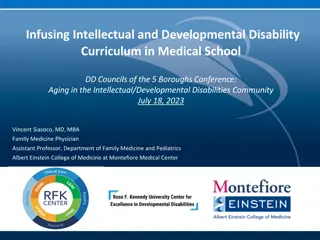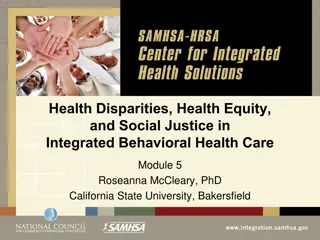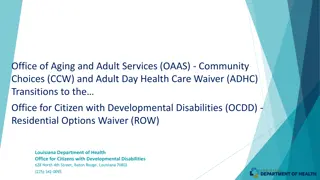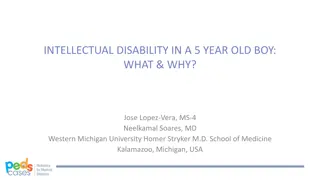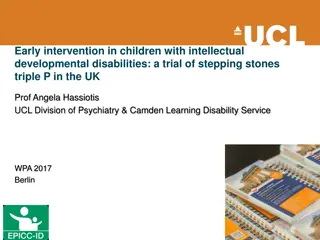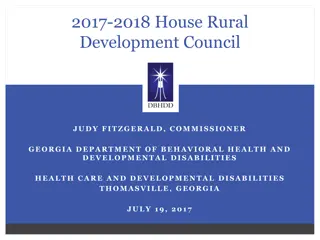Understanding the Health Disparities in People with Intellectual and Developmental Disabilities
The article highlights the pressing need for better information and updated prevalence rates to inform program planning and policies on the health of individuals with intellectual and developmental disabilities (ID/DD). It discusses the challenges in understanding the health-related needs of this population, emphasizing the disparities in health outcomes experienced by adults with ID/DD compared to their peers. The article stresses the importance of addressing these disparities and improving access to appropriate healthcare for individuals with ID/DD.
Download Presentation

Please find below an Image/Link to download the presentation.
The content on the website is provided AS IS for your information and personal use only. It may not be sold, licensed, or shared on other websites without obtaining consent from the author. Download presentation by click this link. If you encounter any issues during the download, it is possible that the publisher has removed the file from their server.
E N D
Presentation Transcript
2017 Annual Disability Statistics Compendium Event Data Needs to Inform Program Planning and Policies on Health of People with Intellectual Disabilities and Developmental Disabilities Jennifer Johnson, EdD, Deputy Director Administration on Intellectual and Developmental Disabilities February 13, 2018
Need for Updated Prevalence Rates There are a handful of varying prevalence rates for the DD population The most commonly accepted on is based on a supplement to the NHIS in the mid- 90s (1.58%) 3
Need for Updated Prevalence Rates Population changes/demographic changes Rates of ID/DD among children are variable and substantially higher than rates among adults. 4
Estimated Prevalence of Child and Adult ID and DD (%) 16 14 12 10 8 6 4 2 0 child ID child DD adult ID Adult DD Boyle* 2011 Larson** 2001 Yang 2015 Maulik 2011 Zablotsky* 2015 Yang 20152 Maenner* 2016 McKenzie 2016 Braun 2015 Larson** 2015 5
Need for Better Health-related Information The health of the ID/DD population has been a longstanding concern We understand their health and health-related needs less well than many other groups. The U.S. spends more per person on the well-being of people with ID/DD compared to the general population, yet the outcomes of those expenditures are disappointing and reflect significant preventable health disparities. 6
What We Know Adults with ID/DD experience poorer health outcomes: Compared with peers of a similar age: They are more likely to live with complex health conditions Have limited access to appropriate health care and health promotion programs Have undetected vision and hearing loss Have mental health problems with potential overuse of psychotropic medications Health disparities are magnified for people who are both from a diverse race/ethnicity and have ID/DD 7
What We Know Individuals with ID/DD are at greater risk for chronic conditions: Higher rates of chronic conditions such as cardiovascular disease, diabetes, arthritis and hypertension Cardiovascular disease is a leading cause of mortality in people with ID/DD as it is in the general population 8
APPROACHES TO GETTING BETTER INFORMATION ON THE ID/DD POPULATION 9
Surveillance Methods Allows for: Repeat administration of the same or highly similar survey repeat cross-sectional data Researchers to track changes in a condition (e.g., changing prevalence rates over time) or in health indicators (e.g., effect of policy changes on outcomes). Pooling of data across multiple years to identify a sufficiently large sample size for subgroup analyses not possible with a single administration. Making population based comparisons Challenges: Case definition How to find cases How to obtain accurate information. A relatively low prevalence of intellectual and developmental disabilities in the general population and the fact that most health surveys in the U.S., including the National Health Interview Survey, exclude institutionalized populations, creates further difficulties. 10
Longitudinal Data Allows for: Assessing the natural history of persons with ID/DD Understand trends Challenges Requires maintaining connection with individuals over time as their contact information changes Potential biases in retention of participants in the database. Not always population based 11
Administrative Data Allows for: Investigation of how social factors, financing systems, organizational structures and processes, health technologies and personal behaviors affect access to care, quality and cost of health care, and ultimately health and well- being It includes analyses of entire health systems to understand utilization patterns and outcomes for the population of enrollees in that system. 12
Administrative Data More recently developed methods link data across multiple administrative data sources. Increasing harmonization across minimum data sets of administrative data allows for greater linkage across data sets to answer new questions. 13
Current Research Special Olympics Healthy Athletes More than two decades of data collection using its free Healthy Athletes screenings Represents the largest data resource for persons with ID/DD - over more than 1.6 million health examinations in countries around the world Studies have reported on the Healthy Athletes screening data for oral health, obesity, vision, hearing, nutrition and general fitness Raised awareness of the unmet health needs of people with ID/DD Limitations: Not nationally representative. Difficulties around individual identifiers in the data further complicate its use in terms of eliminating redundancies and allowing longitudinal analyses. 15
Current Research Residential Information Systems Project (RISP) AIDD funded study of longitudinal trends in residential service setting types, setting sizes, funding authorities, and expenditures for persons with ID/DD. RISP s estimated prevalence of intellectual and developmental disabilities is about 1.48% based on NHIS-D 1994/95 data, with 30% of persons with IDD being known to or served by state agencies in 2014 Limitations: does not emphasize health data. 16
Current Research National Core Indicators Collects indicator information from a sample of people receiving developmental disability services from state agencies. The project most states and the District of Columbia. It captures information for people who are receiving long-term services and supports and has been used to explore programmatic and demographic issues. Reports examine the use of psychotropic medications, health behaviors, access to primary health care, and document significant disparities in health and health care utilization compared to the general population Limitations: Sample limited to people receiving services, and questions persist about true randomization of the sample and adequate standardization of data collection. Proxy reporting is allowed for parts of the data set to ensure people who are not able to self-report are included. 17
NATIONAL HEALTH INTERVIEW SURVEY 18
NHIS Since 1957, NHIS has been used to monitor the health of the U.S. across a broad range of health topics collected through nationally representative household interviews. The NHIS-Disability Supplement was conducted in two phases in 1994 and 1995. The NHIS-D provided invaluable information on the adults with disabilities and for children, those with disabilities as well as special health needs. More than 200 publications have used the NHIS-D data to increase information about health and its determinants for people with disabilities across the lifespan. 19
NHIS Since the special supplement on disability, the NHIS has continued to provide less specific but highly valuable information on the health of people with disabilities broadly, and people with intellectual and developmental disabilities more specifically. 20
Studies Using NHIS for Intellectual and Developmental Disabilities Searched 2005-2017 Intellectual disabilities , developmental disabilities , mental retardation Identified 25 (+4 MEPS articles) Does NOT include search for MEPS studies Does NOT include studies of other disabilities 21
NHIS Studies on Intellectual and Developmental Disabilities (2005-2017) Authors Studies using NHIS Data Boulet et al Boulet et al Boulet et al Boyle et al Dixon-Ibarra et al Houtrow et al Iezzoni et al Landes Landes Lavelle et al Maenner et al Magana et al Magana et al Neely-Barnes et al Pastor et al Pastor et al Pastor et al Phillips et al Pulcini et al Schieve et al Schieve et al Sinclair et al Xiang et al Yamaki Zablotsky et al ` Studies identified in NHIS search that use MEPS data (incomplete list) Bennett et al 2017 Parish et al 2006 Reichard et al 2011 Reichard et al 2011 Year Topic 2009 2010 2011 2011 2014 2014 2016 2017a 2017b 2014 2016 2009 2016 2014 2006 2009 2012 2014 2015 2009 2012 2008 2005 2005 2015 Health care use and functional impact of DD in children Health status and healthcare use for children with sickle cell Birthweight influences on developmental outcomes Trends in prevalence of DD in children 1997-2008 Disability as antecedent to chronic conditions 2006-2012 Trends in prevalence of childhood disability 2001-2011 Pap testing for non-IDD women with chronic disability Association between mortality and education for adults with IDD Mortality risk disadvantage for ID diminishes with age Economic burden of ASD Prevalence of CP and ID 2011-2013 Race/ethnicity -- health behavior and access to care by mothers Race/ethnicity and ID health disparities Parental disability and child mental health: propensity analysis Injury rates in children with ADHD MH Service use by students in special education Prevalence of emotional behavioral problems in children Unhealthy weight prevalence and impact in autism, LD, BD Trends/coexisting conditions SSI children ADHD, ASD, ID Health status in children with Down syndrome Concurrent conditions and care use for children with LD, DD Injury rates for children with different disabilities Non-fatal injury rates for children with disabilities Unhealthy weight in adults with IDD in the community Prevalence and changes in autism, DD with question changes Receipt of recommended services disabilities and diabetes Disparity for women with ID in some preventive services Diabetes in working-age adults with cognitive limitations Health disparities in adults with physical or cognitive disabilities
Number of Publications by Year 6 5 4 3 2 1 0 2005 2006 2007 2008 2009 2010 2011 2012 2013 2014 2015 2016 2017
Focus of Studies (NHIS +MEPS) Prevalence (4) Concurrent Conditions (2) Chronic conditions (1+2) Unhealthy weight (2) Emotional and mental health (2) Health status of specific groups (2) Injury rates (3) Race/ethnicity intersect with disability & disparities (2) Receipt of health care services (1+2) Economic cost of select conditions (1) 24
Focus of Studies (contd) Unique uses: Impact of parenting disability on child (1) Characteristics influencing developmental outcome (1) Mortality and intellectual disability (2) (Linked datasets) Use of ID identifier to exclude from sample (1) 25
NHIS Limitations: Sample does not include institutional samples May exclude persons in aggregate living facilities such as group homes. If group homes are included, it is unclear whether the weighting for household members takes into account the greater density of disabilities in group homes. Will not include issues unique to persons with intellectual and developmental disabilities, such as need for additional services and supports. Data from samples of people with intellectual and developmental disabilities are aggregated across highly heterogeneous individuals, who vary greatly by severity, associated conditions, residential setting, needs for support or assistance and availability of services in their state. 26
SUMMARY 27
Summary Surveillance data are critically important Other types of data and studies are also needed to inform program planning and policy. Longitudinal data Clinical studies Qualitative studies AIDD workgroups 28






